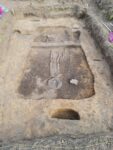 A high-status burial from the late 11th/early 12th century containing an intact bronze bowl and rare matched pair of amber rings has been discovered in Ostrowite in Poland’s Pomeranian Voivodeship.
A high-status burial from the late 11th/early 12th century containing an intact bronze bowl and rare matched pair of amber rings has been discovered in Ostrowite in Poland’s Pomeranian Voivodeship.
Two burials with bronze bowls had been found at the site before, one by the farmer during agricultural work in 2007 (precise location unknown) and the other in 2010 by archaeologists. Fragments of bronze bowls have been found throughout the site, however, and in 2020 and 2021, the team worked with volunteer metal detectorists to pinpoint the likely location of a bowl and therefore a grave.
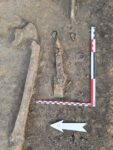 They hit paydirt in 2020 when a trench dug in an area with a concentration of detected bowl fragments unearthed an east-west orientated grave with a bronze bowl at the legs of the deceased (Tomb 80), then they hit it again in 2021 with an even more richly furnished bowl tomb (Tomb 81). While the organic structure of the tomb has not survived, the shape and size indicates it was a wooden chamber grave, a type used by the early medieval elites of Pomerania. Tomb 81 is larger than most at 9.7 feet long and five feet wide. (The average dimensions of the bowl tombs are 8 x 3 feet, and that’s larger than the average size of a non-bowl grave.)
They hit paydirt in 2020 when a trench dug in an area with a concentration of detected bowl fragments unearthed an east-west orientated grave with a bronze bowl at the legs of the deceased (Tomb 80), then they hit it again in 2021 with an even more richly furnished bowl tomb (Tomb 81). While the organic structure of the tomb has not survived, the shape and size indicates it was a wooden chamber grave, a type used by the early medieval elites of Pomerania. Tomb 81 is larger than most at 9.7 feet long and five feet wide. (The average dimensions of the bowl tombs are 8 x 3 feet, and that’s larger than the average size of a non-bowl grave.)
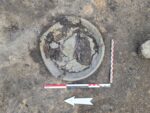 Bronze bowls from the early Middle Ages in Poland are exclusively found in the graves of men. Inside the bowl were two pieces of wood. They were resting on top of the complete bowl, and archaeologists believe they were not left inside of it for funerary purposes, but rather are surviving fragments of the tomb’s wooden roof. Other organic materials have been found on the bowl’s surface (fragments of
Bronze bowls from the early Middle Ages in Poland are exclusively found in the graves of men. Inside the bowl were two pieces of wood. They were resting on top of the complete bowl, and archaeologists believe they were not left inside of it for funerary purposes, but rather are surviving fragments of the tomb’s wooden roof. Other organic materials have been found on the bowl’s surface (fragments of 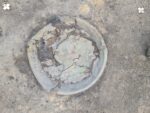 textiles and their imprints) and underside (small fragments of leather, probably remnants of the deceased’s shoes preserved by the copper oxides in the bowl). The knife sheath has similar textile traces preserved on the surface as well.
textiles and their imprints) and underside (small fragments of leather, probably remnants of the deceased’s shoes preserved by the copper oxides in the bowl). The knife sheath has similar textile traces preserved on the surface as well.
Archaeologists also found an iron knife in a leather sheath with bronze fittings, two coin fragments and two amber finger rings buried in thegrave. The first ring was found where the bones of the right hand would have 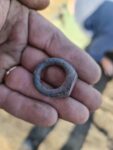 been (the small hand bones have not survived). The second ring was on a finger of the left hand on other side of the body. Amber rings are extremely uncommon grave goods, and finding two in one grave is unique.
been (the small hand bones have not survived). The second ring was on a finger of the left hand on other side of the body. Amber rings are extremely uncommon grave goods, and finding two in one grave is unique.
“The deceased was most likely a representative of the local Pomeranian elite” – Dr. hab. Jerzy Sikora from the Institute of Archeology of the University of Lodz, who has been leading research in Ostrowit for several years. The deceased was placed in a wooden structure of the burial chamber, resembling a very large chest or a small
house. Archaeologists call this type of burial, associated with the early medieval elites, chambered. The fact that the buried person was a Christian is evidenced by the fact that he was not incinerated after his death. In addition, the body was placed on the east-west axis, which was also a practice for Christians.
Tomb 81 is located near two other burials that likely belonged to the elite. They too have the dimensions and shape of a wooden chamber burial, but no clearly identifiable remains of the structures have been found.